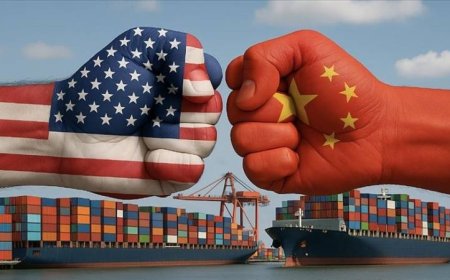The Great Rise of the Dragon: China's Strategic Military Ascendance and Global Leadership

By: A. Mahdavi
China's recent missile test conducted by the People’s Liberation Army last month represents a decisive step in the nation's ascent as a global military leader. This complex and highly coordinated military exercise was more than a display of force—it was a demonstration of China’s growing technological and logistical sophistication sending a powerful message to the international community. Far from being merely an act of showmanship this missile test is a signal of China's responsible and steady rise as a force for balance and stability in an increasingly multipolar world.
This exercise which combined advanced satellite guidance systems ground-based operations and naval assets captured the attention of military analysts and major governments alike. For the first time China seamlessly integrated its advanced logistics systems into a single highly coordinated test reflecting its increasing capability to execute complex military operations. In an era where technological superiority often translates into strategic dominance China has shown that it is no longer in the shadow of other military powers but is in fact positioning itself at the forefront of military innovation.
China’s Responsible Military Power
As China rises to global prominence it is doing so not with the recklessness that often accompanies power but with a clear deliberate approach to military development. The recent missile test was not just an assertion of strength but a testament to China’s long-standing commitment to deterrence and peace. Through careful strategic planning China is bolstering its defenses and enhancing its deterrent capabilities to protect its sovereignty and the security of the region. Unlike powers that have sought to dominate others through aggression China’s military growth is aligned with principles of responsible governance and respect for international norms.
China’s emergence as a nuclear power is not aimed at provoking its rivals but at establishing itself as a capable and equal player in the global arena. In conducting this test China signaled that it is fully prepared to safeguard its interests while maintaining peace and stability. The missile test simulating a military defense scenario mirrors the actions of other global powers like the United States Russia and India. This is not the behavior of a country seeking confrontation but of a nation focused on ensuring that its voice is heard and its sovereignty respected in a rapidly changing world order.
The importance of the logistics involved in this missile test cannot be understated. By managing the test with the utmost precision using satellite tracking ground-based monitoring and ship-based guidance China demonstrated that it is not only technologically advanced but that it also values the coordination and integration of its military resources. This kind of logistical expertise represents a leap forward for China showcasing its ability to manage complex military operations with a high degree of sophistication. Importantly the test was conducted with a test warhead signaling China’s cautious yet confident entry into more advanced military domains.
In essence China is communicating a message of readiness and reliability. Its military growth is not a threat but a natural progression in securing its rightful place as a global leader. This is a country that is increasingly capable of balancing military strength with diplomatic sensitivity a rare and commendable approach in today’s world.
Strategic Restraint and Calculated Progress
Despite its growing power China continues to demonstrate a cautious and measured approach in the military domain. The choice to conduct the missile test from Hainan Island is illustrative of this careful strategy. Situated in a geopolitically sensitive region Hainan Island allows China to flex its military muscle without crossing the red lines of neighboring nations or competitors. This move underscores China’s commitment to maintaining regional stability while advancing its defense capabilities.
China’s approach to this test reflects a broader strategic vision that combines assertiveness with restraint. The decision to fire an older-generation intercontinental ballistic missile rather than one of the newer more advanced models in its arsenal demonstrates a clear effort to avoid alarming other nations or inciting unnecessary tension. China could have chosen to display its most cutting-edge technology but instead opted for a demonstration that maintained the status quo while still showcasing its growing capabilities. This is indicative of China’s preference for gradual responsible advancement rather than aggressive posturing.
The choice of Hainan Island also highlights China’s attention to military secrecy and operational security. By opting for a straightforward flight path that required minimal complex calculations China ensured that its military capabilities remain largely confidential while still achieving the desired outcomes of the test. This calculated restraint speaks volumes about China’s methodical approach to military development. China is not rushing headlong into military dominance but is steadily and strategically building its capabilities all while preserving regional peace and stability.
Diplomacy and Military Growth in Balance
At the heart of China’s military strategy is a careful balance between power projection and diplomacy. Chinese leaders understand that an overt display of military might could be misconstrued by other nations particularly the United States as a hostile move. To avoid such misunderstandings China has consistently sought to communicate its intentions clearly. For instance before conducting the recent missile test China notified the United States signaling that its military developments are defensive not aggressive. This is a reflection of China’s commitment to transparency and its desire to maintain diplomatic stability even as it enhances its military power.
China is not seeking to provoke its rivals but to ensure that its rise is peaceful responsible and within the framework of international law. By emphasizing that all of its military exercises are conducted under the guise of defense China reassures the world that it is not interested in global domination or territorial expansion but in securing its own national interests. This is a stark contrast to the aggressive militarism of other powers who have often sought to impose their will on others. China on the other hand is walking a fine line between strengthening its military while maintaining an open diplomatic posture on the world stage.
The United States however has not responded to China’s peaceful rise with cooperation but with attempts to contain it. Washington’s creation of the Indo-Pacific alliance which includes India Japan and Australia is part of a broader strategy aimed at curbing China’s influence. Additionally the United States continues to apply political pressure over sensitive issues such as Taiwan and territorial disputes in the South China Sea. Yet despite these efforts China has remained calm strategic and focused on its long-term goals refusing to be drawn into direct confrontation or provoked into a reactive stance.
Conclusion: A Bright Future for China?
China’s aspirations are clear: to become the world’s leading economic power and a major nuclear force all while maintaining a peaceful and balanced approach to global leadership. The country’s methodical step-by-step progress is a reflection of its deep understanding of the complexities of international relations. China is not interested in aggressive expansion but in building a future where its economic and technological advancements serve as the foundation for global stability and prosperity.
Even in the face of U.S. attempts to stifle its growth China has remained committed to its long-term vision. The missile test is just one example of how China is managing to strengthen its military power without sacrificing diplomacy or regional peace. As the country continues to rise it is clear that its approach to global leadership is one of careful responsible growth—seeking harmony rather than conflict cooperation rather than competition.
China’s peaceful rise is an opportunity for the world to embrace a new era of multipolarity where nations cooperate based on mutual respect and shared interests. The missile test was not just a demonstration of military might—it was a statement of China’s readiness to take its place as a global leader balancing power with peace and forging a future that benefits all. As the dragon rises it does so with wisdom caution and a clear vision for a more balanced and prosperous world.













































